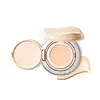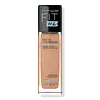What's inside
What's inside
 Key Ingredients
Key Ingredients

 Benefits
Benefits

 Concerns
Concerns

 Ingredients Side-by-side
Ingredients Side-by-side

Water
Skin ConditioningCI 77891
Cosmetic ColorantCyclopentasiloxane
EmollientPhenyl Trimethicone
Skin ConditioningTrimethylsiloxysilicate
EmollientPropylene Glycol Dibenzoate
Skin ConditioningGlycerin
HumectantButylene Glycol
HumectantCetyl PEG/PPG-10/1 Dimethicone
EmulsifyingCyclohexasiloxane
EmollientAlcohol
AntimicrobialLauryl PEG-9 Polydimethylsiloxyethyl Dimethicone
Skin ConditioningCI 77492
Cosmetic ColorantPolymethylsilsesquioxane
Dimethicone
EmollientIsododecane
Emollient1,2-Hexanediol
Skin ConditioningDisteardimonium Hectorite
StabilisingLauryl PEG-10 Tris(Trimethylsiloxy)Silylethyl Dimethicone
EmulsifyingMica
Cosmetic ColorantAcrylates/Dimethicone Copolymer
Skin ConditioningAcrylates/Polytrimethylsiloxymethacrylate Copolymer
Skin ConditioningMagnesium Sulfate
Sorbitan Sesquioleate
EmulsifyingPhenoxyethanol
PreservativeCI 77491
Cosmetic ColorantTribehenin
EmollientTriethoxycaprylylsilane
Aluminum Hydroxide
EmollientGlyceryl Behenate
EmollientPolyglyceryl-6 Octastearate
EmulsifyingDivinyldimethicone/Dimethicone Crosspolymer
Skin ConditioningCI 77499
Cosmetic ColorantSqualane
EmollientArmillaria Mellea Extract
Skin ConditioningEthylhexylglycerin
Skin ConditioningCaprylyl Glycol
EmollientParfum
MaskingCaffeine
Skin ConditioningCyclodextrin
AbsorbentSilica Dimethyl Silylate
EmollientPentylene Glycol
Skin ConditioningPropanediol
SolventCaprylic/Capric Triglyceride
MaskingTocopherol
AntioxidantHydrogenated Polyisobutene
EmollientPentaerythrityl Tetra-Di-T-Butyl Hydroxyhydrocinnamate
AntioxidantCamellia Sinensis Leaf Extract
AntimicrobialGanoderma Sinense Extract
Skin ConditioningPaeonia Suffruticosa Extract
Skin ConditioningPanax Ginseng Root Extract
EmollientErgothioneine
AntioxidantLotus Corniculatus Seed Extract
Skin ConditioningMaltodextrin
AbsorbentOlea Europaea Fruit Extract
BleachingSaussurea Involucrata Extract
HumectantWater, CI 77891, Cyclopentasiloxane, Phenyl Trimethicone, Trimethylsiloxysilicate, Propylene Glycol Dibenzoate, Glycerin, Butylene Glycol, Cetyl PEG/PPG-10/1 Dimethicone, Cyclohexasiloxane, Alcohol, Lauryl PEG-9 Polydimethylsiloxyethyl Dimethicone, CI 77492, Polymethylsilsesquioxane, Dimethicone, Isododecane, 1,2-Hexanediol, Disteardimonium Hectorite, Lauryl PEG-10 Tris(Trimethylsiloxy)Silylethyl Dimethicone, Mica, Acrylates/Dimethicone Copolymer, Acrylates/Polytrimethylsiloxymethacrylate Copolymer, Magnesium Sulfate, Sorbitan Sesquioleate, Phenoxyethanol, CI 77491, Tribehenin, Triethoxycaprylylsilane, Aluminum Hydroxide, Glyceryl Behenate, Polyglyceryl-6 Octastearate, Divinyldimethicone/Dimethicone Crosspolymer, CI 77499, Squalane, Armillaria Mellea Extract, Ethylhexylglycerin, Caprylyl Glycol, Parfum, Caffeine, Cyclodextrin, Silica Dimethyl Silylate, Pentylene Glycol, Propanediol, Caprylic/Capric Triglyceride, Tocopherol, Hydrogenated Polyisobutene, Pentaerythrityl Tetra-Di-T-Butyl Hydroxyhydrocinnamate, Camellia Sinensis Leaf Extract, Ganoderma Sinense Extract, Paeonia Suffruticosa Extract, Panax Ginseng Root Extract, Ergothioneine, Lotus Corniculatus Seed Extract, Maltodextrin, Olea Europaea Fruit Extract, Saussurea Involucrata Extract
Water
Skin ConditioningCyclohexasiloxane
EmollientNylon-12
Isododecane
EmollientAlcohol Denat.
AntimicrobialCyclopentasiloxane
EmollientPEG-10 Dimethicone
Skin ConditioningCetyl PEG/PPG-10/1 Dimethicone
EmulsifyingPEG-20
HumectantPolyglyceryl-4 Isostearate
EmulsifyingDisteardimonium Hectorite
StabilisingPhenoxyethanol
PreservativeMagnesium Sulfate
Disodium Stearoyl Glutamate
CleansingHdi/Trimethylol Hexyllactone Crosspolymer
Titanium Dioxide
Cosmetic ColorantMethylparaben
PreservativeAcrylates Copolymer
Tocopherol
AntioxidantButylparaben
MaskingAluminum Hydroxide
EmollientAlumina
AbrasiveSilica
AbrasiveGlycerin
HumectantCI 77891
Cosmetic ColorantCI 77491
Cosmetic ColorantCI 77492
Cosmetic ColorantCI 77499
Cosmetic ColorantCeramide AP
Skin ConditioningWater, Cyclohexasiloxane, Nylon-12, Isododecane, Alcohol Denat., Cyclopentasiloxane, PEG-10 Dimethicone, Cetyl PEG/PPG-10/1 Dimethicone, PEG-20, Polyglyceryl-4 Isostearate, Disteardimonium Hectorite, Phenoxyethanol, Magnesium Sulfate, Disodium Stearoyl Glutamate, Hdi/Trimethylol Hexyllactone Crosspolymer, Titanium Dioxide, Methylparaben, Acrylates Copolymer, Tocopherol, Butylparaben, Aluminum Hydroxide, Alumina, Silica, Glycerin, CI 77891, CI 77491, CI 77492, CI 77499, Ceramide AP
 Reviews
Reviews

Ingredients Explained
These ingredients are found in both products.
Ingredients higher up in an ingredient list are typically present in a larger amount.
Aluminum Hydroxide is a form of aluminum. It can be naturally found in nature as the mineral gibbsite. In cosmetics, Aluminum Hydroxide is used as a colorant, pH adjuster, and absorbent.
As a colorant, Aluminum Hydroxide may add opacity, or reduce the transparency. Aluminum hydroxide is contains both basic and acidic properties.
According to manufacturers, this ingredient is an emollient and humectant. This means it helps hydrate the skin.
In medicine, this ingredient is used to help relieve heartburn and help heal ulcers.
There is currently no credible scientific evidence linking aluminum hydroxide in cosmetics to increased cancer risk.
Major health organizations allow the use of aluminum hydroxide in personal care products and have not flagged it as a carcinogenic risk at typical usage levels.
Learn more about Aluminum HydroxideThis ingredient is a high molecular weight silicone. It has emulsifying and skin conditioning properties.
Ci 77491 is also hydrated iron III oxide. It's sole purpose is to give a red/pink hue to products.
Iron III oxides are classified as inorganic chemicals for coloring.
Synthetically created Ci 77491 is considered safer than those naturally found. This is because the synthetically created version may contain less impurities. Iron oxides are generally non-toxic and non-allergenic.
Learn more about CI 77491Ci 77492 is also hydrated iron III oxide. It's sole purpose is to give a yellow hue to products.
Iron III oxides are classified as inorganic chemicals for coloring.
Synthetically created Ci 77492 is considered safer than those naturally found. This is because the synthetically created version may contain less impurities. Iron oxides are generally non-toxic and non-allergenic.
Learn more about CI 77492Ci 77499 is also hydrated iron III oxide. It is created from mixing red and black iron oxides. This helps give shades of darkness to a product.
Iron III oxides are classified as inorganic chemicals for coloring.
Ci 77891 is a white pigment from Titanium dioxide. It is naturally found in minerals such as rutile and ilmenite.
It's main function is to add a white color to cosmetics. It can also be mixed with other colors to create different shades.
Ci 77891 is commonly found in sunscreens due to its ability to block UV rays.
Learn more about CI 77891Cyclohexasiloxane is a type of silicone more commonly known as D6. It is an emollient and solvent.
Cyclohexasiloxane is used to evenly distribute ingredients throughout the product. When applied to the skin, Cyclohexasiloxane evaporates and leaves behind a silky feel.
As an emollient, it can help the skin feel soft and hydrated. It is also used to reduce frizz in hair products.
Learn more about CyclohexasiloxaneCyclopentasiloxane, or D5, is a silicone used to improve texture of products and trap moisture.
D5 is considered lightweight and volatile. Volatile means it evaporates quickly after application. Once evaporated, D5 leaves a thin barrier that helps keep skin hydrated.
It is also an emollient. Emollients help soften the skin and prevent water loss. Silicones create a silky texture in products. D5 helps other ingredients become more spreadable.
Studies show D5 is safe to use in skincare products. We recommend speaking with a skincare professional if you have concerns.
Learn more about CyclopentasiloxaneDisteardimonium Hectorite comes from the clay mineral named hectorite. It is used to add thickness to a product.
It can also help stabilize a product by helping to disperse other ingredients.
Hectorite is a rare, white clay mineral.
Learn more about Disteardimonium HectoriteGlycerin is already naturally found in your skin. It helps moisturize and protect your skin.
A study from 2016 found glycerin to be more effective as a humectant than AHAs and hyaluronic acid.
As a humectant, it helps the skin stay hydrated by pulling moisture to your skin. The low molecular weight of glycerin allows it to pull moisture into the deeper layers of your skin.
Hydrated skin improves your skin barrier; Your skin barrier helps protect against irritants and bacteria.
Glycerin has also been found to have antimicrobial and antiviral properties. Due to these properties, glycerin is often used in wound and burn treatments.
In cosmetics, glycerin is usually derived from plants such as soybean or palm. However, it can also be sourced from animals, such as tallow or animal fat.
This ingredient is organic, colorless, odorless, and non-toxic.
Glycerin is the name for this ingredient in American English. British English uses Glycerol/Glycerine.
Learn more about GlycerinIsododecane is a fragrance, emollient, and solvent.
As an emollient, it helps your skin stay soft and hydrated. Emollients help trap moisture into your skin.
Isododecane's role as a solvent makes it a great texture enhancer. It spreads smoothly on skin and does not leave a sticky feeling behind. Isododecane also helps prevent color transfer in makeup products.
Isododecane is not absorbed into skin.
Learn more about IsododecaneMagnesium Sulfate is a salt. More specifically, it is an epsom salt, or the bath salt used to help relieve muscle aches.
Despite having ‘sulfate’ in the name, it isn’t a surfactant or cleansing agent like sodium lauryl sulfate. Unlike those sulfates, magnesium sulfate doesn’t have the same cleansing or foaming properties (it's simply a type of salt).
In cosmetics, Magnesium Sulfate is used to thicken a product or help dilute other solids. It is a non-reactive and non-irritating ingredient.
One study shows magnesium deficiency may lead to inflammation of the skin. Applying magnesium topically may help reduce inflammation.
You can find this ingredient in sea water or mineral deposits.
Learn more about Magnesium SulfatePhenoxyethanol is a preservative that has germicide, antimicrobial, and aromatic properties. Studies show that phenoxyethanol can prevent microbial growth. By itself, it has a scent that is similar to that of a rose.
It's often used in formulations along with Caprylyl Glycol to preserve the shelf life of products.
Tocopherol (also known as Vitamin E) is a common antioxidant used to help protect the skin from free-radicals and strengthen the skin barrier. It's also fat soluble - this means our skin is great at absorbing it.
Vitamin E also helps keep your natural skin lipids healthy. Your lipid skin barrier naturally consists of lipids, ceramides, and fatty acids. Vitamin E offers extra protection for your skin’s lipid barrier, keeping your skin healthy and nourished.
Another benefit is a bit of UV protection. Vitamin E helps reduce the damage caused by UVB rays. (It should not replace your sunscreen). Combining it with Vitamin C can decrease sunburned cells and hyperpigmentation after UV exposure.
You might have noticed Vitamin E + C often paired together. This is because it is great at stabilizing Vitamin C. Using the two together helps increase the effectiveness of both ingredients.
There are often claims that Vitamin E can reduce/prevent scarring, but these claims haven't been confirmed by scientific research.
Learn more about TocopherolWater. It's the most common cosmetic ingredient of all. You'll usually see it at the top of ingredient lists, meaning that it makes up the largest part of the product.
So why is it so popular? Water most often acts as a solvent - this means that it helps dissolve other ingredients into the formulation.
You'll also recognize water as that liquid we all need to stay alive. If you see this, drink a glass of water. Stay hydrated!
Learn more about Water